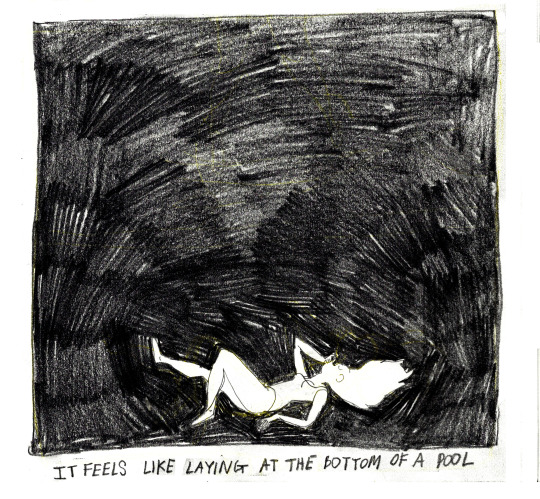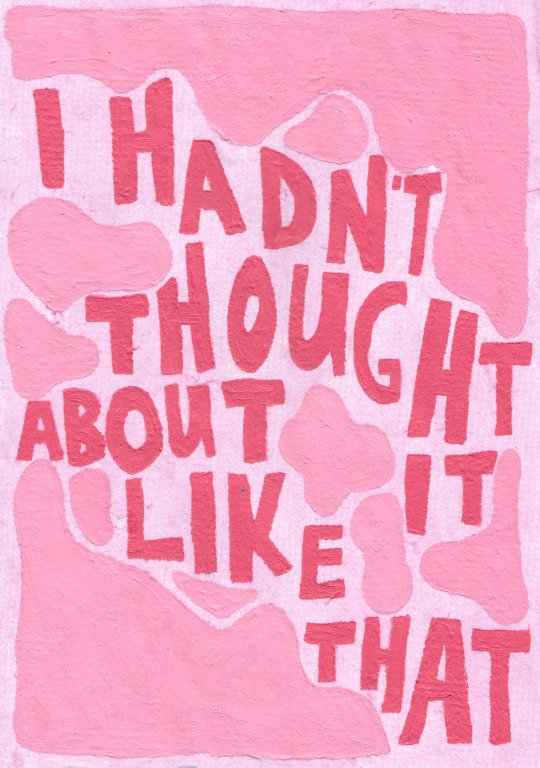Photo

Jonas Mekas . As I Was Moving Ahead Occasionally I Saw Brief Glimpses Of Beauty . 2000
4K notes
·
View notes
Text
The inherent embarrassment in desiring anything
104K notes
·
View notes
Photo

Tracey Emin, The Last Thing I Said to You was Don’t Leave Me Here II, 2000
This photograph, which was published in an edition of six, is a self-portrait of the artist sitting naked on the floor in the corner of a beach hut. Her back is to the camera and she leans slightly forward. A small tattoo of a scorpion is visible on her left shoulder blade. Thick gold necklaces glint at the nape of her neck. Her pose recalls the vulnerable, dejected figure of a punished child. Paint is peeling from the walls of the empty hut, giving it a ramshackle appearance which heightens the mood of pathos. Emin bought the beach hut in Whitstable, Kent with her friend, the artist Sarah Lucas (born 1962), in 1992. Emin used the hut as a weekend retreat, going there with her boyfriend. She has talked about the importance of owning property for the first time, saying, ‘I was completely broke and it was really brilliant, having your own property by the sea’ (quoted in Lobel). In 1999, she transported the hut from the beachfront to the gallery, titling it The Last Thing I Said to You is Don’t Leave Me Here (The Hut), 1999 (Saatchi Gallery, London). The Hut was exhibited for the first time in London in Ant Noises (part two) at the Saatchi Gallery in 2000. (The show’s title was an anagram of Sensation, the 1997 exhibition of work by young British artists in the Saatchi Collection at the Royal Academy, London.) The installation was accompanied by two photographs including the work now owned by Tate. The companion image, The Last Thing I Said to You was Don’t Leave Me Here I, 2000 (National Portrait Gallery, London), shows the artist kneeling on the floor of the hut. She is seen from the side as she leans forward placing her right hand on her knee. Her eyes are closed. Emin has described why she chose to photograph herself naked, saying, ‘The hut is a bare and naked thing. I thought it made perfect sense if I was. It’s also got some kind of weird, religious look in it, like I’m praying or something’ (quoted in Lobel). There is a meditative quality to Emin’s postures in the photographs, and her nudity suggests that she is enacting a private ritual of purification or sacrifice. In the Tate work the space is particularly confined. The angle of the camera looking down on the figure huddled in the corner puts the viewer in a position of authority. The title suggests that the image documents the aftermath of a lovers’ quarrel, with the woman abandoned in an inhospitable environment. Emin’s work is highly confessional. The Last Thing I Said to You was Don’t Leave Me Here II invites an autobiographical narrative reading but because, unlike in many of her text-based works (see Tracey Emin C.V., 1995, Tate T07632), the story is hinted at rather than spelt out, the viewer is left to draw his or her own conclusions about what may have happened in the hut. The photograph looks like both the staged reconstruction of an incident from the artist’s past and her attempt to derive some peace from a distressing memory. The image invites the viewer to empathise with the artist and to respect the emotional honesty with which she documents and shares her pain.
83 notes
·
View notes














